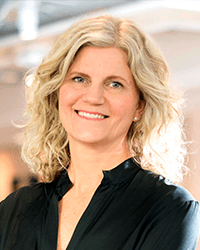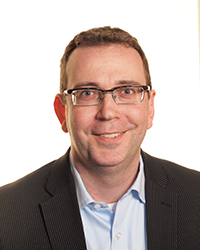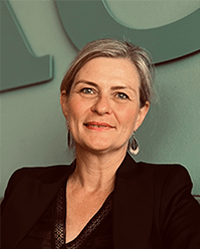Anna Thelander
Leader in communication and marketing
Anna Thelander holds a university degree in business economics and has been engaged in management, marketing, branding, sales, and strategic development throughout her entire career. Most recently, she served as the Marketing and Communications Manager at AMF Fastigheter, one of Sweden’s largest real estate companies. Prior to that, she held positions such as Marketing Director at Tikkurila Sverige AB, Marketing Manager at GS1 Sweden/ECR Sverige, and Sales and Marketing Director at Besthand AB.
Her interest in and desire to further develop her skills in change and transformation processes led her to participate in Leading Strategic Change at INSEAD.
READ MORE...– Changes and change management are areas I have worked with in all my leadership roles, and I also find it fun and interesting. I chose to participate because I wanted more knowledge about the methods within the field but also to gain inspiration externally and knowledge about how others handle change processes. Moreover, I was already familiar with INSEAD and knew that the quality of their programs is at a high level, says Anna Thelander.
Professional and competent instructors
She emphasizes that the program lived up to the high expectations she had.
– The professors were very professional and competent, managing to combine the latest research with practical exercises in an interesting way. During the program, we also conducted a simulation exercise, which was a really good way to test our new knowledge. And the mix of participants, all with extensive experience in leading change processes, was excellent – there were many who had interesting experiences and tips to share, she says.
According to Anne Thelander, much of the learning from the program was related to an increased awareness of how important the cultural aspect is in a change or transformation process.
– 90 percent of the reasons why changes fail is related to internal factors. It could be, for example, unclear strategy, insufficiently defined actions, unclear roles, and poor communication. Therefore, we need to discuss and base our approach on the corporate culture when initiating and leading changes: What culture do we have, what culture do we want, and how does it affect the change work? These are questions we should ask, she points out, and concludes:
– Changes are constant and something we must live with all the time. But with some new methods and tools in my toolbox, I will undoubtedly become better at planning and especially implementing my next change project.
Niels Kau Andersen
VP Quality Assurance, Chr. Hansen
Niels Kau Andersen, who is responsible for quality assurance in the biotech company Chr. Hansen, has a scientific educational background in the form of a civil engineering degree in chemistry from DTU, which he has subsequently supplemented with an HD in organization and management. As “the last shot on the educational tree”, he recently completed the INSEAD program Leading Strategic Change.
– I took the HD in organization and strategy when I started my management career. I really appreciate being academically challenged on, among other things, management theories and cases that are based on hard science. And in terms of my background, which is a lot about statistics and numbers, it is essential for me to challenge myself in relation to cultural understanding, change management and strategy, as this is an important part of my job, he says and continues:
– And that is precisely the reason why I chose to go to INSEAD and participate in Leading Strategic Change. Over recent years, we have acquired several companies in Chr. Hansen. The companies represent very different cultures, and therefore cultural understanding in relation to these processes is absolutely fundamental. Because of our global “footprint”, we have always had to operate across cultures, but the strategic work of integrating acquisitions has of course just given it an additional dimension – we have to deal with cultures both at “company level” and at “country level”. It is important for us to be very aware of how culture plays a role, and I have no doubt that cultural understanding has an impact on how strong we subsequently become.
READ MORE...Nice balance between theories and cases
According to Niels Kau Andersen, the level of the program was high, and it hit well in relation to the fact that all participants were challenged.
– I think that the balance between on the one hand the academic and theoretical and on the other the practical was really fine – the business cases illustrated the theoretical perspectives very well. The professors had world-class professionalism and a genuine interest in the subject area, and they were able to dig deeper when challenged with additional questions.
He highlights three key-learnings in particular, which will be important for his work going forward.
– The strategy model, which was presented with its three dimensions: product, customers and efficiency, was on the one hand very simple, and on the other hand it contained a lot of depth. It is a model I have been able to use from day one, and it has definitely made me and my strategy work much sharper. Another important learning relates to the so-called “competing framework” from cultural education. The model is based on the fact that when, for example, acquiring other companies, you should not look at where we have cultural differences, but where our cultures overlap with each other, so that we can build on common strengths. In conclusion, I would like to mention the inspiration and the network I have gained with the other participants. We were tied together in a really good way, and I have gained extremely useful and usable insight into a large number of other industries.
Physical presence doubles the payoff
Niels expects the network to be able to be used in the future if he encounters problems or challenges that he wants to discuss with others.
– We come home with a common understanding and a common conceptual framework, so it is easy to reach out to each other. An at least equally important perspective concerns, here on the other side of corona, how fantastic it has been to participate in an education with physical presence. Not only are we physically present, we also travel away together for a week to INSEAD to learn together, where there is also time for social activities.
Kate Holm Sorensen
Partner, chief consultant and occupational psychologist, UKON A/S
Kate Holm Sørensen has just completed the program Leading Strategic Change at INSEAD. She has 25 years of experience in management and organizational development and is a partner in UKON, which is one of Denmark’s leading consultancies within organizational psychology and management. A central part of the work at UKON is to create a strong and sustainable integration between strategy, organization and people.
– My notebook is filled to the brim with gold nuggets, and my head is filled with good hands-on tools after a particularly exciting and educational week at INSEAD with a focus on strategic changes and transformation processes, says Kate Holm Sørensen.
According to Kate, one of the heavy nuggets the future must be built on is precisely strong networks and relationships. We must be able to team up for complex change tasks when it really matters – and here it is important that we have some balance in the relations account that we can draw on.
READ MORE... Four important ingredients She highlights four important ingredients in strong and professional networks and relationships, which she has opened her eyes to even more during the week-long programme, namely: expertise, emotions as a resource, tensile strength and curiosity. – Expertise is about the knowledge, experience and competence we ourselves bring to the table in relation to creating mutual success. It does not come by itself, but is built up through personal character traits such as persistence and endurance. Next, I have become even more aware of emotional intelligence as an important resource, and how important it is that we are smart about both our own and other people’s emotions. The art is to get the emotions to work with us and the task, and not against, says Kate Holm Sørensen, before she concludes: – And then there is “tensility”, which is a new word in my vocabulary, which is about the number and quality of the contact points around which our relationships are built. It is important that we connect to each other and commit ourselves on a personal level, that we meet each other as whole people and not just with the professional role and mask. In conclusion, curiosity is an essential ingredient. Curiosity is precisely the driving force in relation to being investigative and developing, but at the same time an important driver for the three previously mentioned ingredients. Curiosity can make people, relationships and the business grow to the highest degree.




